Dermatomyositis: what is it, causes, symptoms, treatment, complications, prognosis
Attention! The information is for informational purposes only and is not intended to diagnose and prescribe treatment. Always consult your specialist doctor!
Content
- What is dermatomyositis?
- Causes
- Main symptoms and complications
- Complications
- Diagnostics
- Treatment
- Recommendations
- Forecast
What is dermatomyositis?
Dermatomyositis (polymyositis and other names for this disease: Wagner disease, Wagner-Unferricht-Hepp disease, purple disease) Is an inflammatory disease of muscles (myositis), skin, and blood vessels that affects about 3 out of 1 million people a year. The reason is unknown. The primary symptoms of dermatomyositis include muscle weakness and skin rashes.
All age and ethnic groups are affected. Most cases begin in children aged 5-10 years and in adults aged 40-50 years. Women (and girls) are affected about twice as often as men (and boys).
Patients with dermatomyositis develop weakness in the large muscles around the neck, shoulders, and thighs. This causes difficulty climbing stairs, getting out of a chair or out of bed, or brushing your hair. Most patients experience mild muscle pain, which distinguishes them from patients with other forms of muscle disease.
Many patients with other diseases also complain of weakness; however, when questioned carefully, in reality, they simply show fatigue, shortness of breath, or depressionbut they don't really suffer from muscle weakness.
Causes
Wagner's disease refers to a group of muscle diseases or disorders called inflammatory myopathies.
The cause of most inflammatory myopathies is unknown; however, the leading theory is that the body's immune system mistakenly starts attacking muscle cells, blood vessels in the skin and muscles, causing damage, rashes, and weakness.
Sometimes dermatomyositis is associated with cancer and may be a sign of the development of certain cancers, such as lungs' cancer, breast, ovary, prostate and colon. It can also be associated with other diseases of the immune system, such as, for example, scleroderma and mixed connective tissue disease.
Main symptoms and complications

Patients with dermatomyositis have various symptoms. They range from mild muscle weakness, such as difficulty getting up from a chair or rolling over in bed, to severe symptoms, including profound weakness or difficulty swallowing. Patients may also develop rashes or skin changes ranging from mild redness to more severe ulceration (see section 4.4). Photo).
Dermatomyositis symptoms may include:
- muscle weakness, especially in the scapular, pelvic and cervical regions, symmetrically and with gradual deterioration;
- the appearance of red spots or small lumps on the skin, especially in the joints of the fingers, elbows and knees, is called a symptom or Gottron's papule;
- purple spots on the upper eyelids called heliotrope (see. photo above);
- joint pain and swelling;
- fever;
- fatigue;
- difficulty swallowing;
- abdominal pain;
- vomiting;
- weight loss.
Typically, people with this condition may have difficulty doing daily activities such as brushing their hair, walking, climbing stairs, or getting out of a chair. In addition, skin symptoms may worsen with sun exposure.
In more severe cases, or when dermatomyositis occurs in combination with other autoimmune diseases, may other organs such as the heart, lungs or kidneys are affected, which affects its function and causes serious complications.
When to see a doctor?
Onset without causative muscle pain with concomitant reddish-purple patches on the skin should prompt the person concerned to seek immediate medical attention to clarify the situation.
Complications
When muscle breakdown and scleroderma affect the internal organs (esophagus, lungs, heart, etc.), the patient suffering from dermatomyositis is subject to sedimentation, as he undergoes:
- Difficulty swallowing (dysphagia)followed by nutritional problems and so-called aspiration pneumonia. All these difficulties arise as a result of changes in the smooth muscles of the digestive system (especially the first tracts). The resulting nutritional problems lead to sudden weight loss and severe malnutrition.
Note:pneumonia Is an inflammation of the lungs caused by food, saliva or nasal secretions entering the bronchial tree. Typical symptoms are cough, fever, headache, shortness of breath, shortness of breath, and general malaise.
- Breathing problems. When the intercostal muscles that allow breathing are involved, and when scleroderma affects the airways, people with dermatomyositis have great difficulty breathing.
- Heart problems. Because of inflammation of the heart muscle (i.e. myocardium) may occur arrhythmias different types and heart failure.
In addition, unusual calcium build-ups in the skin and muscles (calcification) may occur, especially among younger patients.
Diagnostics
Some aspects of the history and clinical examination deserve special attention as they allow carry out differential diagnostics with other diseases, as well as with the presence of concomitant diseases. In addition, they have prognostic and therapeutic value.
The diagnosis of dermatomyositis is made by evaluating the symptoms of the disease, a physical assessment, and examinations such as a muscle biopsy, electromyography or blood tests to detect the presence of substances that indicate muscle breakdown, such as CPK, DHL or AST, for example.
There may be production of autoantibodies such as myositis specific antibodies (MSAs), eg anti-RNP or anti-MJ. which can be found in large quantities in blood tests.
To confirm the diagnosis, the doctor also needs to differentiate the symptoms of dermatomyositis from other conditions that cause similar symptoms, such as polymyositis or myositis with incorporated bodies, which are also inflammatory muscle diseases.
Other diseases to consider are myofascitis, necrotizing myositis, rheumatic polymyalgia or inflammation caused by medications such as, for example, clofibrate, simvastatin, or amphotericin.
Treatment
Treatment for dermatomyositis is carried out according to the symptoms presented by the patients, but in most cases involves the use of:
- Corticosteroids, such as prednisone, because they reduce inflammation in the body;
- Immunosuppressantssuch as methotrexate, azathioprine, mycophenolate or cyclophosphamide, to reduce the response of the immune system;
- Other meanssuch as hydroxychloroquine is useful for relieving dermatological symptoms such as sensitivity to light.
These drugs are usually taken in high doses for extended periods of time and have the effect of reducing inflammation and reducing symptoms of the disease. When these drugs do not work, another treatment option is to administer human immunoglobulin.
It is also possible to conduct physiotherapy sessions with rehabilitation exercises that help relieve symptoms and prevent contractures and retractions. Photoprotection with sunscreens is also indicated to prevent skin deterioration.
When dermatomyositis is associated with cancer, the most appropriate treatment is cancer treatment, often resulting in relief of the signs and symptoms of the disease.
Recommendations
Dermatomyositis weakens the skin, especially the areas affected by the rash. Therefore, doctors recommend that you do not expose yourself to too much sun exposure or do it only after taking the necessary measures. precautions (protective sunscreen, appropriate clothing, etc.) as UV rays can further worsen situation.
In addition, it is recommended:
- Consult your doctor for any information regarding dermatomyositis and possible concomitant diseases.
- Stay active to tone the muscles of the body.
- In case of extreme fatigue, rest and allow the body to recuperate.
- If signs or symptoms have ever occurred before, contact your doctor immediately.
- If you are depressed due to illness, trust your friends and family. In fact, closeness and withdrawal will only harm therapy.
Forecast
Once upon a time, when the current methods of therapy for polymyositis did not yet exist, the prognosis was negative, and the 5-year survival rate from the onset of symptoms was very low.
However, today, thanks to advances in medicine, the prognosis has improved significantly, and the indicators survival rates after 5 and 10 years from the onset of dermatomyositis are 70% and 57%, respectively (according to estimates 2012).
Attention! The information is for informational purposes only and is not intended to diagnose and prescribe treatment. Always consult your specialist doctor!



